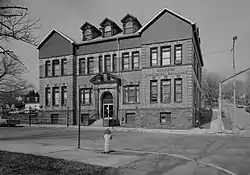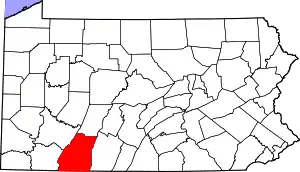Windber, Pennsylvania
Windber is a borough in Somerset County, Pennsylvania, United States, about three miles (4.8 km) south of Johnstown. It was at one time a place of industrial activities which included coal mining, lumbering, and the manufacture of fire brick. In 1897, the community was founded by coal barons Charles and Edward Julius Berwind, owners of the Berwind Corporation; the name "Windber" simply switches the order of the two syllables in the family name "Berwind".[3] 8,013 people lived in Windber in 1910 and 9,057 in 1940; the population was 4,138 at the 2010 census. It is part of the Johnstown, Pennsylvania Metropolitan Statistical Area.
Windber, Pennsylvania | |
|---|---|
Borough | |
 Municipal building | |
 Location of Windber in Somerset County, Pennsylvania. | |
| Coordinates: 40°14′07″N 78°49′51″W | |
| Country | United States |
| State | Pennsylvania |
| County | Somerset |
| Settled | 1897 |
| Incorporated | July 3, 1900 |
| Government | |
| • Type | Borough Council |
| • Mayor | Mike Thomas |
| Area | |
| • Total | 1.98 sq mi (5.12 km2) |
| • Land | 1.98 sq mi (5.12 km2) |
| • Water | 0.00 sq mi (0.00 km2) |
| Population (2010) | |
| • Total | 4,138 |
| • Estimate (2019)[2] | 3,816 |
| • Density | 1,929.22/sq mi (745.01/km2) |
| Time zone | UTC-5 (Eastern (EST)) |
| • Summer (DST) | UTC-4 (EDT) |
| Zip code | 15963 |
| Area code(s) | 814 Exchange: 467 |
| FIPS code | 42-85632 |
| Website | Windber Borough |
History
Windber started in 1897 as a company town for nearby coal mines in the vicinity of Johnstown. The Berwind-White Coal Mining Company imported workers from eastern and southern Europe and exploited ethnic divisions in the area (which had been settled by Germans and Irish in the 19th century). On Good Friday 1922, coal miners walked out of the mines in Windber and several nearby locations in Somerset County, attempting to force the mine owners to recognize their United Mine Workers union, as well as accurately weigh the coal they mined. The company employed legal tactics (the United States Supreme Court decided two lawsuits) as well as strike-breakers, but the miners received considerable favorable national publicity and local support and held out until the end of the following summer.[4] However, the UMW successfully organized the mines during 1933, after the Great Depression led to the election of President Franklin Delano Roosevelt.
The Windber Historic District was listed on the National Register of Historic Places in 1991.[5]
Frank Kush, all-American football lineman at Michigan State who achieved distinction (and later controversy) as head coach of the Arizona State college football team and Hamilton Tiger-Cats of the Canadian Football League was born and raised in Windber.
The Vintage Electric Streetcar Company, popularly called the "trolley graveyard", is located in Windber. The private scrapyard houses a number of PCC streetcars and other transit equipment from systems like the MBTA Green Line, which are sold for reuse or scrapped for parts.[6]
Geography
Windber is located at 40°14′7″N 78°49′51″W (40.235161, -78.830864).[7]
According to the United States Census Bureau, the borough has a total area of 2.1 square miles (5.4 km2), all of it land.
Demographics
| Historical population | |||
|---|---|---|---|
| Census | Pop. | %± | |
| 1910 | 8,013 | — | |
| 1920 | 9,462 | 18.1% | |
| 1930 | 9,205 | −2.7% | |
| 1940 | 9,057 | −1.6% | |
| 1950 | 8,010 | −11.6% | |
| 1960 | 6,994 | −12.7% | |
| 1970 | 6,332 | −9.5% | |
| 1980 | 5,585 | −11.8% | |
| 1990 | 4,756 | −14.8% | |
| 2000 | 4,395 | −7.6% | |
| 2010 | 4,138 | −5.8% | |
| 2019 (est.) | 3,816 | [2] | −7.8% |
| Sources:[8][9][10] | |||
As of the census[9] of 2000, there were 4,395 people, 2,019 households, and 1,185 families residing in the borough. The population density was 2,118.8 people per square mile (819.8/km2). There were 2,177 housing units at an average density of 1,049.5 per square mile (406.1/km2). The racial makeup of the borough was 99.29% White, 0.07% Native American, 0.09% Asian, 0.02% Pacific Islander, 0.16% from other races, and 0.36% from two or more races. Hispanic or Latino of any race were 0.57% of the population.
There were 2,019 households, out of which 25.1% had children under the age of 18 living with them, 43.3% were married couples living together, 10.8% had a female householder with no husband present, and 41.3% were non-families. 38.7% of all households were made up of individuals, and 22.6% had someone living alone who was 65 years of age or older. The average household size was 2.16 and the average family size was 2.89.
In the borough the population was spread out, with 21.3% under the age of 18, 6.7% from 18 to 24, 25.3% from 25 to 44, 22.1% from 45 to 64, and 24.6% who were 65 years of age or older. The median age was 43 years. For every 100 females there were 85.4 males. For every 100 females age 18 and over, there were 81.9 males.
The median income for a household in the borough was $23,261, and the median income for a family was $31,860. Males had a median income of $24,861 versus $18,886 for females. The per capita income for the borough was $15,078. About 11.9% of families and 11.1% of the population were below the poverty line, including 13.5% of those under age 18 and 8.8% of those age 65 or over.
Crime
Windber has ranked safer than 13% of small cities and towns in Pennsylvania.
Government
Windber Borough Council:
- Mike Bryan, President of Council
- James Spinos, Vice President of Council
- John Holden
- Joe Pallo
- Doug Ledney
- Ron Mash
- Pete Lamonaca
Windber Borough Government Officials:
- Mike Thomas, Mayor
- Robin S. Gates, Borough Secretary/Administrative Assistant
- James Furmanchick, Borough Manager
Education
- Windber Area School District
- Windber Area High School
- Windber Area Middle School
- Windber Area Elementary School
Entertainment
The nearby Silver Drive-In first opened in 1962.[11] While other such facilities in the area have closed over the course of years, the Silver survived through public outcry over proposals to close and demolish it, making a comeback in 2005.[12][13][14] It is now the only drive-in theater in the Johnstown, Pennsylvania region.
Notable people
- Jim Bonfanti, drummer for the power-pop band the Raspberries, was born in Windber.
- Bill Elko, professional football player, grew up in Windber.[15]
- Alan Freed, radio disc jockey who coined the term "Rock and Roll," was born in Windber.
- Dave Geisel, retired MLB player
- Mark A. Heckler, President of Valaparaiso University
- Gene Heeter, a professional football player for the New York Jets, was born in Windber.
- Frank Kostro, retired MLB player
- Frank Kush, football coach, was born in Windber.
- Johnny Weissmuller, winner in the 1920s of five Olympic gold medals in swimming and one bronze medal in water polo, and later was a Hollywood star best known for his Tarzan movies, particularly with actress Maureen O'Sullivan, lived in Windber as a child. (He was born in what is now Timișoara, Romania)
- J. Irving Whalley, a former United States congressman and a member of the Automotive Hall of Fame, lived for years in Windber.
See also
References
- "2019 U.S. Gazetteer Files". United States Census Bureau. Retrieved July 28, 2020.
- "Population and Housing Unit Estimates". United States Census Bureau. May 24, 2020. Retrieved May 27, 2020.
- Espenshade, A. Howry (1925). Pennsylvania Place Names. State College, PA: Pennsylvania State College. p. 237.
- historic marker at http://explorepahistory.com/hmarker.php?markerId=1-A-2CF
- "National Register Information System". National Register of Historic Places. National Park Service. July 9, 2010.
- Hoover, Amanda (September 6, 2015). "Why are old Green Line trolleys wasting away in rural Pennsylvania?". Boston Globe. Retrieved September 7, 2017.
- "US Gazetteer files: 2010, 2000, and 1990". United States Census Bureau. 2011-02-12. Retrieved April 23, 2011.
- "Census of Population and Housing". U.S. Census Bureau. Retrieved December 11, 2013.
- "U.S. Census website". United States Census Bureau. Retrieved January 31, 2008.
- "Incorporated Places and Minor Civil Divisions Datasets: Subcounty Resident Population Estimates: April 1, 2010 to July 1, 2012". Population Estimates. U.S. Census Bureau. Retrieved December 11, 2013.
- (12 June 2009). Reel success - County Amusement noting 60 years in movie business, The Tribune-Democrat
- (12 December 2008). Silver screen saved, The Tribune-Democrat
- (11 August 2006). Artist's touch adds character (s) to drive-in, The Tribune-Democrat
- (7 September 2008). Silver Drive-In owner mulls rezoning, sale, The Tribune-Democrat
- "At Last, Some D For San Diego - Sports Illustrated Vault". SI.com. Retrieved December 10, 2020.
External links
| Wikimedia Commons has media related to Windber, Pennsylvania. |
- Borough website
- Windber Area School District
- Historic American Engineering Record (HAER) No. PA-322, "Town of Windber"
